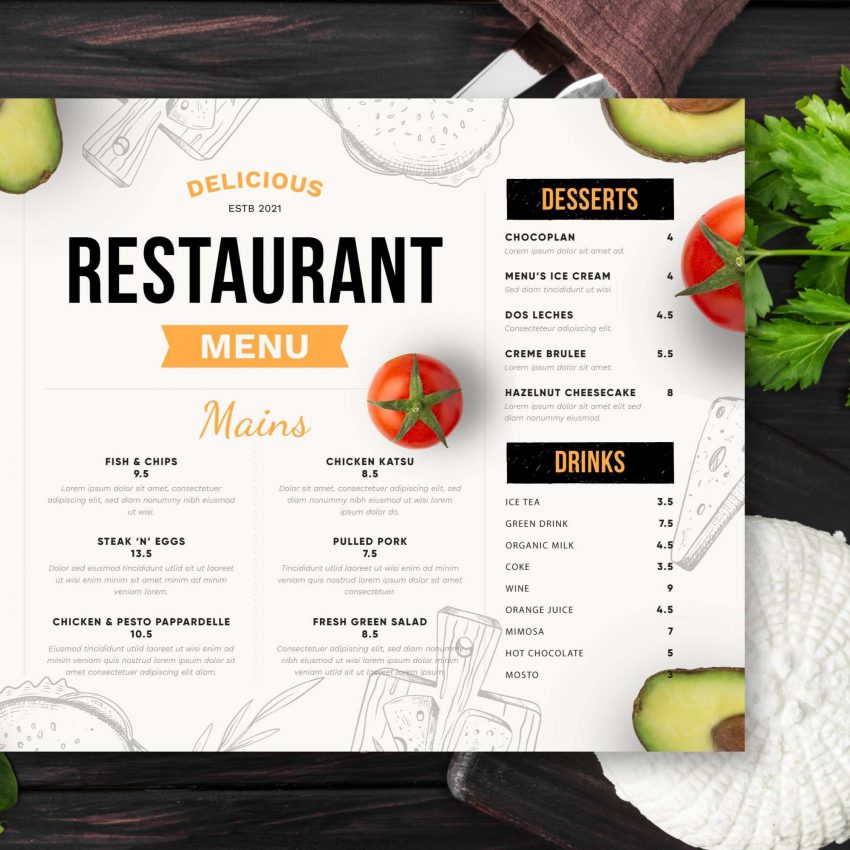A well-designed menu is an essential part of your restaurant’s identity and is more than just a list of items. The best restaurant menus not only showcase what a restaurant offers but also enhance the dining experience. To help you create a menu that entices patrons and distinguishes your restaurant from the competition, check out some of the best ideas for restaurant menus.
Why do we need good restaurant menus design?
A thoughtfully designed menu can make a lasting impression on customers. It affects what they eat, represents your brand, and may even increase sales by emphasizing meals that are profitable. Whether you’re starting a new establishment or updating your present menu, menu ideas for restaurants will guide you toward success.
1. Keep It Simple and Clean
One of the most effective menu ideas for restaurants is simplicity. A neat, clear menu improves the eating experience by being easy to read for patrons. Stick to a few well-chosen typefaces and limit the quantity of colors to achieve a coherent design.
Tip: To make it easier for clients to browse through your selections, arrange your menu into distinct parts (appetizers, mains, desserts, etc.).
2. Highlight Signature Dishes
Every restaurant has certain special meals that are the highlights of the menu or are popular among the patrons. Ensure that these menu items are easily identifiable as trademark meals.
Tip: Don’t only sell the dish’s elements in your descriptions; instead, sell the dish’s experience. It sounds more enticing to say “Juicy grilled salmon with a tangy lemon butter sauce” than it does to merely say “grilled salmon.”
3. Incorporate Visual Elements
Incorporating photos or illustrations is one of the most popular restaurants menu ideas to help make your menu more engaging. However, be careful not to overdo it—too many images can make the menu look cluttered and unprofessional.
Tip: Use professional food photography or minimalist illustrations to create a balance between visual appeal and functionality.
4. Use Typography Wisely
Your font selections should complement the design and ambiance of your restaurant. For instance, a warm, rustic restaurant may choose hand-drawn or serif fonts, while a trendy cafe would employ sleek, minimalist fonts.
Tip: To maintain a tidy menu, stick to no more than two or three font choices. For section headers, use bolder font sizes, while for descriptions, use lower font sizes.
6. Emphasize Menu Balance
Menu balance is key when designing the best restaurant menus. A menu that is well-balanced facilitates client selection and guarantees that each area receives equal emphasis.
Tip: Avoid lining up all prices along the right edge of the menu, as it can make customers focus solely on cost. Instead, integrate prices subtly within the description.
7. Seasonal or Rotating Menu Inserts
Offering changing or seasonal menu inserts is another fantastic menu concept for eateries. This enables you to highlight new or seasonal goods and maintain the main menu’s conciseness.
Tip: Use inserts to highlight chef specials, farm-to-table ingredients, or themed events.
8. Utilize Color Psychology
Colors have the power to arouse feelings and shape consumer behavior. When creating your menu, use color psychology to gently influence your clients’ decisions.
Tip: Use colors that complement the logo of your business to create a warm and inviting ambiance.
9. Interactive Digital Menus
With the rise of technology, digital menus are becoming increasingly popular. Many restaurants are now using tablets or QR codes that link to a digital menu.
Tip: Use an online ordering menu that allows you to update items quickly and offer dynamic content, such as pairing recommendations or customer reviews.
10. Make Your Menu Accessible
Lastly, accessibility is crucial when designing restaurant menus. Use larger fonts, clear contrasts, and ensure the text is easily readable in low-light settings.
Tip: Consider offering a braille menu or digital options for customers with special needs.
By following these restaurant menu ideas, you can create a menu that not only looks great but also enhances customer satisfaction and boosts sales. Whether you opt for a simple, minimalist design or a more elaborate, themed menu, the key is to ensure your menu reflects your brand, is easy to navigate, and highlights your best offerings.
